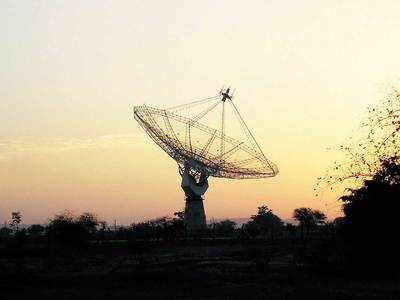
Experts study astronomical explosion
by Sukhada KhandgeDeemed brighter than a supernova, it has been ejecting material at an unusually high speed
A team of scientists from National Centre for Radio Astrophysics of the Tata Institute of Fundamental Research (NCRA-TIFR) were a part of the discovery that successfully measured the unusual high speed of the ejected material form a transient (an astronomical explosion). The entity, called CSS161010, categorised as Fast Blue Optical Transients (FBOTs), ejected material having hydrogen.
It was a first in 2018, when astronomers witnessed a powerful astronomical explosion, much brighter than a normal supernova, which displayed bright emission at X-ray, UV, optical and radio wavelength, but faded rapidly in a matter of days. It was named “Cow” (AT 2018cow). It dazzled the astronomers due to its peculiar properties, as did the recent observations, and was classified as FBOT.
They used the Giant Metrewave Radio Telescope (GMRT), the Karl G Jansky Very Large Array (VLA) and the Chandra X-ray Telescope in researching CSS161010.
Poonam Chandra and A J Nayana from NCRA-TIFR along with Deanne Coppejans and R Margutti from Northwestern University, accompanied by Mari-Ela Chock from WM Keck Observatory were part of this research. GMRT provided the most crucial measurement at low-radio frequencies to estimate the speed of the ejected material.
While explaining their discovery, the scientists informed that the most exciting part is the speed of the transient. Chandra said, “The speed of the transient was the most interesting element since it was unusual. The speed was close to half of the speed of light.”
She added, “While we have robot telescopes on, we observed that suddenly there was a light which was not present a few days ago — it diminished over the next few days. After using GMRT, we observed the transient and then calculated its time.”
What makes these luminous FBOTs unique is that these initially looked like supernova explosions, but flared up and vanished much faster. They’re also extremely hot, hence appear bluer than standard supernovae. Talking about the same, Coppejans said, “This was unexpected as we know of energetic stellar explosions that can eject material at almost the speed of light, specifically gamma-ray bursts, but they only launch a tiny amount of mass — about 1millionth the mass of the sun. In contrast, CSS161010 launched 1to 10 per cent the mass of the sun to relativistic speeds — this is clearly a new class of transient.”
“We detected CSS161010 in late 2016, but initially everyone thought CSS161010 to be a normal transient, but we noticed some peculiar properties usually not seen in normal supernovae,” said Coppejans.
“It was only after we conducted follow-up radio and X-ray observations that the true nature of CSS161010 revealed itself. The data showed we were looking at something new and highly energetic, it also highlighted the importance of data at multiple wavebands,” he said.
Chandra informed that after their discovery it is also clear that this transient is hydrogen-rich and it explodes the same.